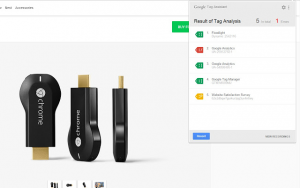Sections
How to Tell if Your eCommerce Sales Are Tracking Properly
There are promotions to dream up, marketing campaigns to build, and, of course, fulfilling and shipping orders. If you run an eCommerce site, the holidays are already nail-biting enough.
The last thing you want to deal with in the middle of this prime sales season is wondering if your sales are tracking properly.
Here’s how to know if your eCommerce sales tracking is working, along with different ways to test it whenever you need some extra reassurance.
What Counts as a "Sale"?
Before you check your sales tracking setup, it can be helpful to understand what, exactly, counts as a “sale.”
The answer seems obvious. Whenever someone completes an order on your eCommerce store, that counts as a sale. While this is true for your online store, Google Ads, Google Analytics, and other third-party platforms have their own definitions.
These platforms rely on you to define what makes a “sale.” They’re designed to monitor all types of conversions, from completed eCommerce orders (the traditional “sale” definition) to form registrations, app installs, or clicks to call a number listed in a PPC ad.
To minimize discrepancies between your eCommerce analytics and Google Ads, you’ll need to define a sale as a website purchase.
That’s step one: confirming that your eCommerce platform and Google are aligned on what counts as a “sale.” Step two is understanding the different rates at which these platforms count those sales. The gap between these rates is known as a “latency period.”
How Latency Periods Affect Sales Tracking
As the place where the sale occurred, it makes sense that your eCommerce site will be the fastest at tracking a sale. In some cases, as with Shopify, the sales data gets updated every minute. Other eCommerce platforms may take longer, but they’re generally quite fast.
Google Ads and Google Analytics will always be playing catch up. They simply can’t track sales as quickly, due to the inescapable fact that they’re third-party platforms. They have to wait for the data to sync between your website and their platform.
In Google, sales data gets updated within 24 to 48 hours. Sites with lower traffic are closer to that 24-hour mark, while sites with over 200,000 daily sessions only get refreshed once per day, leaning closer toward that two-day delay.
Never Miss a Report or Alert
Stay on top of your sales numbers with custom reports and alerts. Your Marketing People can help you set them up so you’ll always be in the know.

How to Test if Your Sales Tracking Is Set Up and Working Properly
First, you’ll need to set up sales tracking on your eCommerce site. To do this, you’ll add a snippet of code to your eCommerce dashboard or manually within the code itself. You’ll get this code snippet from Google Ads, Google Analytics, Facebook Analytics, or any other third-party tracking software you’re using. You can find instructions for setting up conversion tracking with Google Ads here, and here for Google Analytics.
Once you’ve done that, it’s time to ensure everything is tracking properly. Below we walk you through the process using Google Ads.
Sign into Google Ads and click the tools icon in the upper right corner. Navigate to Measurement > Conversions, and check the Status column. Here, you’ll see one of the following four phrases:
- Recording conversions – Congratulations! Your sales tracking is working. Google can “see” your tracking tag and has tracked sales in the past 7 days.
- Unverified – This means that Google can’t see the tag on your order checkout page. This may appear for the first 24 hours after setting up your tracking tag but shouldn’t afterward. If it’s still there, something’s wrong.
- No recent conversions – This means that Google can see your tracking tag, but you haven’t had any conversions in the past 7 days. If this sounds unlikely, something’s wrong.
- Tag inactive – Google can’t see your tag anymore, and hasn’t tracked any sales in the past 7 days. Hover over the status to see the last date your tracking tag was seen, and the last date any sales were recorded. If either of these seem questionable, something’s wrong.
How to Troubleshoot Sales Tracking with Google Ads
If you received one of the last three status codes, it’s time to troubleshoot what’s wrong.
First, confirm with your eCommerce site has indeed had sales. Also check that your Google Ads campaigns are turned on and working.
Next, confirm that the tracking tag is on the right page (i.e. your checkout screen). On Shopify, this may have /checkout/thank_you in the URL). View the Source Code for the page to review the tag code. It will look something like this: <!– Event snippet for {Action name} conversion page –>
Alternately, you can use the free Chrome extension called Tag Assistant. This helpful tool automatically checks the Google code snippets for any page on your website, including details about which tags it can see, whether there are any errors present, and how to fix it.
 >
>Finally, make a test purchase. Search for a keyword you’re bidding on, click on your ad, and make a purchase on your site. Wait to see if it shows up in your Google Ads account within the next 24 hours.
Is Stress-Free Sales Tracking Possible?
Yes, it is! If you want to make sure everything is working as it should, contact Your Marketing People. Our paid search experts and reporting gurus make sure all your systems play well with each other so your sales get tracked accurately.







